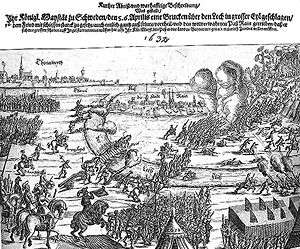Battle of Rain
| Battle of Rain or Battle of Lech or Battle of the River Lech | |||||||
|---|---|---|---|---|---|---|---|
| Part of the Thirty Years' War | |||||||
 | |||||||
| |||||||
| Belligerents | |||||||
|
|
| ||||||
| Commanders and leaders | |||||||
|
|
| ||||||
| Strength | |||||||
| 40,000 | 25,000 | ||||||
| Casualties and losses | |||||||
| 2,000 dead | 3,000 dead | ||||||
The Battle of Rain (also called the Battle of the River Lech or Battle of Lech) was fought on April 15, 1632, as part of the Thirty Years' War. The forces involved in this conflict were 40,000 Swedish troops under Gustavus Adolphus and 25,000 Catholic League troops under Johan Tserclaes, Count of Tilly. It was the second meeting between the two legendary generals (see First Breitenfeld when Tilly received the first setback of his long and storied career) and like at Breitenfeld, Tilly lost when Gustavus forced the River Lech under the cover of his superb artillery, and as there, Tilly was wounded several times and fell during the battle and was carried from the field by his men, (who called him Father Tilly), — only this time, he would not recover from his wounds.
Battle
Gustavus had a bridge of boats constructed across the Lech river near the city of Rain through the night prior to the battle, and in the morning sent three hundred Finnish Hackapelite troops across the river under fire. The Hackapelites dug earthworks for batteries which then protected the rest of Gustavus' army as they crossed the river. As soon as his army had crossed the river, Gustavus immediately and successfully stormed the hill. Tilly was shot in the leg early in the battle and was moved to the rear; his second in command, Johann von Aldringen, was knocked unconscious with a skull fracture minutes later. Maximilian I, Elector of Bavaria, ordered an immediate retreat to save the now leaderless army, leaving most of the Catholic League's baggage and artillery in the field. The army itself may only have escaped destruction due to a storm and high winds blocking roads in the night that followed.[1]
Aftermath
The immediate result of the battle was that Bavaria lay open for occupation by the Swedish army, enabling Gustavus Adolphus to temporarily threaten the Austrian heartland.
Tactics
The battle is, however, more interesting from a tactical point of view rather than from its outcome, as the elaborate plan of Gustavus Adolphus to catch the entire Imperial army by complex maneuvering was prevented when Tilly was mortally wounded in the battle, resulting in the early retreat of the Imperial army. The Swedish battle plan consisted of two major elements:
1. A strong feint attack by a portion of the Swedish infantry with heavy artillery support against Tilly's strongly fortified center behind the river Lech. The intended effect was to attract the full attention of the Imperial army and its reserve. The Swedish force succeeded in establishing and fortifying its position on a small island or peninsula close to the Imperial side of the river. From this position, it was able to repel a series of fierce Imperial counterattacks despite being outnumbered.
2. As the Imperial army got tied up in desperate attempts to eliminate the Swedish bridgehead, the Swedish cavalry with no opposition or attention from the enemy was able to cross the river 10 km south of the Imperial left wing. From this position they intended to outflank the entire Imperial army and thus catch it in a position with the river and the Swedish infantry at its front and the Swedish cavalry in its rear and on its flanks.
With Tilly mortally wounded, the morale of the Imperial army quickly dissolved and the army withdrew before the arrival of the Swedish cavalry. Thus, Tilly's death possibly saved his army from annihilation. Nonetheless, both armies suffered considerable losses (3,000 on the Imperial side, 2,000 on the Swedish), mostly due to frontal attacks and counterattacks against fortified positions with strong natural defenses.
The battle of Lech proves more than the Battle of Breitenfeld the innovation of Gustavus Adolphus' tactical imagination. His daring frontal attack in combination with the deployment of a large part of his army for the flanking movement has similarities with the tactics of John Churchill, Duke of Marlborough at the Blenheim battlefield, (situated in the very neighborhood of Rain) or of Frederick the Great at Leuthen. The disciple of Gustavus Adolphus, Johan Banér, also employed a similar battle plan four years later in the battle of Wittstock.
See also
References
- ↑ C.V. Wedgwood 1961 [1938] The Thirty Years War (Anchor Books: Garden City New York) pp.305--306
2. Friedrich Schiller 2012 [1806] History of the Thirty Years' War in Germany (Kessinger: Whitefish Monanta) pp. 239–242
Coordinates: 48°41′25″N 10°55′02″E / 48.6902°N 10.9172°E